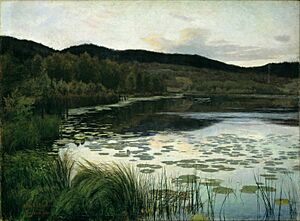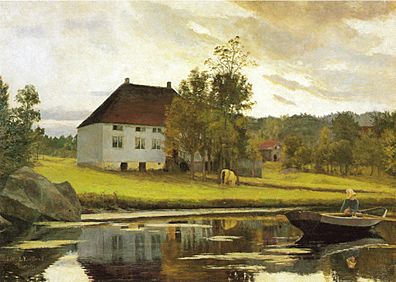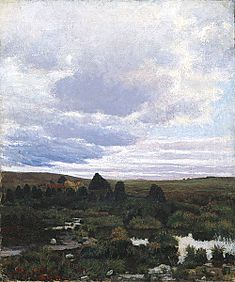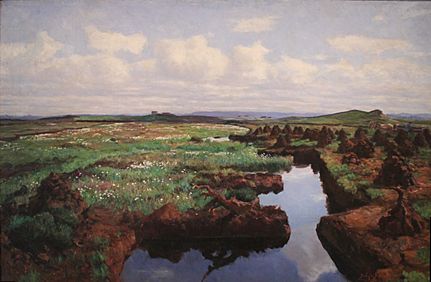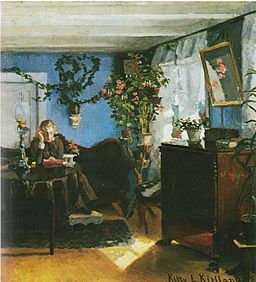Kitty Lange Kielland facts for kids
Quick facts for kids
Kitty Lange Kielland
|
|
|---|---|
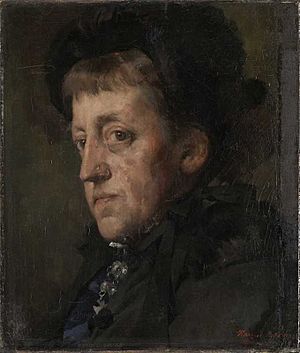
Portrait by Harriet Backer (1880)
|
|
| Born |
Kitty Lange Kielland
8 October 1843 |
| Died | 1 October 1914 (aged 70) |
| Nationality | Norwegian |
| Education | Hans Gude Hermann Baisch Eilif Peterssen Léon Pelouse |
Kitty Lange Kielland (born October 8, 1843 – died October 1, 1914) was a famous Norwegian artist. She was known for painting beautiful landscapes.
Contents
Early Life and Art Training
Kitty Kielland grew up in a wealthy family in Stavanger, Norway. Her older brother was the writer Alexander Kielland. Their talks together were very important for Kitty's journey as an artist.
Even though she learned some drawing and painting when she was younger, Kitty wasn't allowed to train as a professional artist until she was 30 years old. In 1873, she traveled to Karlsruhe, Germany. There, she was taught by the famous artist Hans Gude.
Because she was a woman, Kitty had to take private lessons from Gude. She could not join his regular landscape painting class. Gude taught her to paint things exactly as they looked in real life, a style called realism. This way of painting really stuck with Kitty and you can see it in her later artworks. She learned very quickly during her two years with Gude.
Studying in Munich
In 1875, Kitty left Karlsruhe and moved to Munich, Germany. Many other Norwegian artists lived and worked there, forming a community. In Munich, she studied with Hermann Baisch, who was also a realist painter. She also learned from the Norwegian artist Eilif Peterssen. Some people believe Peterssen was her most important teacher. Kitty lived in Munich until 1878 before moving to Paris.
Painting the Jæren Landscape
In 1876, Kitty Kielland visited a place called Jæren in southern Norway. Her old teacher, Hans Gude, had visited Jæren earlier and told her she should go there to paint.
Kitty made many sketches while she was in Jæren. Later, she used these sketches to paint the flat landscapes of the area when she returned to Munich. She was the first artist to paint Jæren in this way! Her paintings of Jæren showed the landscape realistically, but also captured the feeling of the air and light.
Kitty went back to Jæren every summer. The wide, flat lands and peat bogs (wet, marshy areas) became her favorite things to paint. She said she loved Jæren because of "the grandeur of the landscape and the wealth of poverty." This means she saw both the grand beauty of the land and the simple, hardworking life of the people there. Her skill in painting these scenes showed she was one of Gude's best students.
Life in Paris
In 1879, Kitty Kielland moved to Paris, France. From 1880 to 1888, she shared an art studio with another Norwegian artist, Harriet Backer. In Paris, Kitty showed her paintings to the public for the first time at art exhibitions.
For a short time, she also took lessons from a landscape painter named Léon Germain Pelouse. He lived near Paris in a town called Cernay-la-Ville. Kitty left Paris in 1889. A painting of her by the artist Anna Ancher, made just before she left, can be found in a museum called Anchers Hus.
Later Years and Legacy
In the 1890s, Kitty Kielland started to make her art simpler. She was influenced by the artist Jens Ferdinand Willumsen. She also took part in important discussions about women's rights, showing her strong belief in equality.
Kitty showed her artwork at a big event called the World's Columbian Exposition in Chicago, USA, in 1893. This was a very important world's fair.
Towards the end of her life, Kitty painted less. She became unwell for several years and passed away in Kristiania, Norway, in 1914.
Today, a street in Bærum, a town near Oslo, is named after her to honor her contributions to art.
Selected Works


